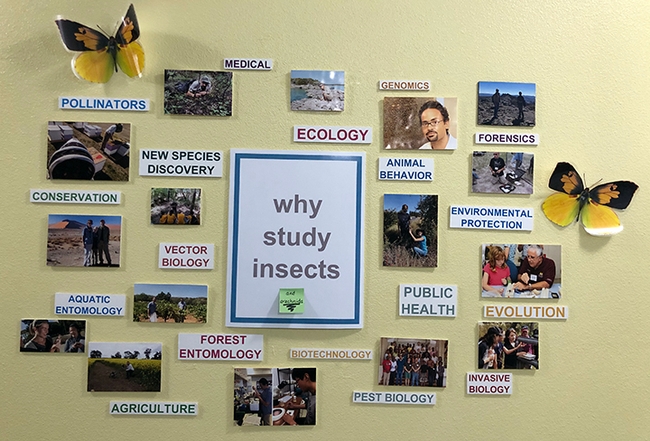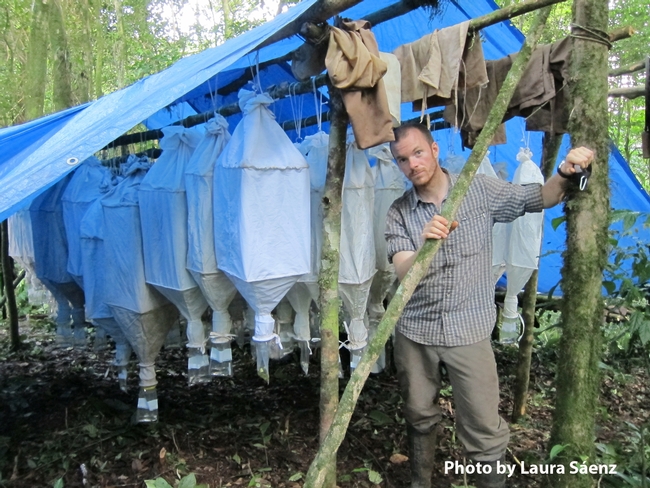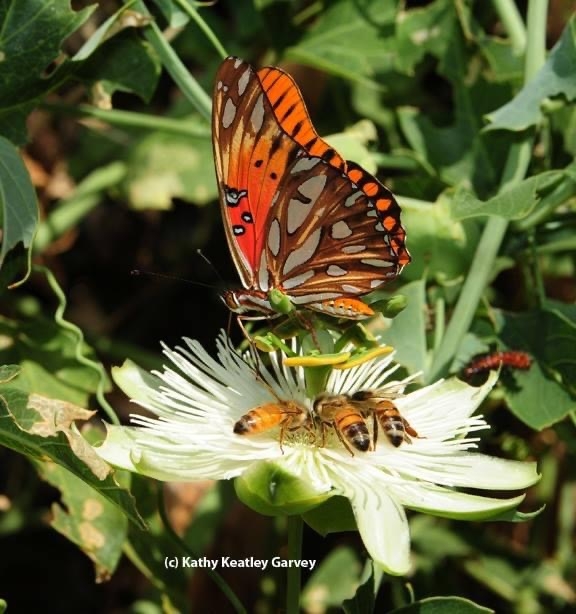- Author: Kathy Keatley Garvey
That's the title of a poster next to the door of the Bohart Museum of Entomology, located in Room 1124 of the Academic Surge Building, 455 Crocker Lane, UC Davis.
The poster specifies possible careers, listing pollinators, medical, genomics, animal behavior, forensics, environmental protection, public health, evolution, pest biology, invasive biology, pest biology, biotechnology, forest entomology, agriculture, aquatic entomology, vector biology, conservation and new species discovery.
Images of California's state insect, the California dogface butterfly, Zerene eurydice, decorate the poster. The butterfly is also the featured insect in the Bohart Museum's logo.
Not to be left out, someone from the nearby laboratory of arachnologist Jason Bond added to the "Why Study Insects" poster: "Arachnids!" Yes, let's study arachnids, too! Bond is the Evert and Marion Schlinger Endowed Chair, UC Davis Department of Entomology and Nematology, and associate dean, UC Davis College of Agricultural and Environmental Sciences. And he's the president-elect of the American Arachnological Society. (See news story)
The Entomological Society of America (ESA) defines entomology as the study of insects. "Entomologists study bees, ants, beetles, termites, mosquitoes, and other insects, as well as other related animals (known as arthropods), such as spiders and scorpions...While it has been estimated that there are as many as 30 million species of insects on the planet Earth, only about one million have actually been discovered and described."
Another factoid from ESA: "Many animals, such as birds, fish, and snakes, eat insects, so they are an important part of the food chain. And without insect pollinators, global vegetation would largely collapse. At the same time, other insects are important decomposers — they eat dead plants and animals, which releases nutrients back into the soil so that new plants and animals can grow. Still other insects are parasites or predators, and they help control the populations of other species. Entomologists study insects and other animals in their habitats, which teaches us how to preserve and restore natural ecosystems."
How many insects are there in the world? According to the Smithsonian Institute, "there are some 10 quintillion (10,000,000,000,000,000,000) individual insects alive."
"In the United States, the number of described species is approximately 91,000," the Smithsonian says. "The undescribed species of insects in the United States, however, is estimated at some 73,000. The largest numbers of described species in the U.S. fall into four insect Orders: Coleoptera (beetles) at 23,700, Diptera (flies) at 19,600, Hymenoptera (ants, bees, wasps) at 17,500, and Lepidoptera (moths and butterflies) at 11,500."
"Recent figures indicate that there are more than 200 million insects for each human on the planet! A recent article in The New York Times claimed that the world holds 300 pounds of insects for every pound of humans."
Another factoid from the Smithsonian: "Most authorities agree that there are more insect species that have not been described (named by science) than there are insect species that have been previously named. Conservative estimates suggest that this figure is 2 million, but estimates extend to 30 million."
"While it has been estimated that there are as many as 30 million species of insects on the planet Earth, only about one million have actually been discovered and described."
So, we're not running out of insects any time soon!
The Bohart Museum of Entomology, directed by UC Davis distinguished professor Lynn Kimsey, houses a global collection of eight million insect specimens. It is part of the UC Davis Department of Entomology and Nematology, ranked as one of the nation's leading entomology departments. Department chair is Professor Joanna Chi, a molecular geneticist-physiologist. Vice chair is associate professor Rachel Vannette, a community ecologist.

- Author: Kathy Keatley Garvey

"Ants are the most successful group of social insects on the Earth," says Branstetter, Postdoctoral Fellow at the Smithsonian Institution, Washington, D.C. and a UC DAvis alumnus. "They occur in almost all terrestrial habitats and are often numerically dominant and ecologically important. Furthermore, ants are diverse. There are likely to be more than 20,000 species worldwide and among these species there is a staggering amount of morphological and behavioral variation."
"It's not just the red ant and black ant. Some species are predatory and have large trap-jaw mandibles. Some are farmers, growing fungus gardens inside their nests. Some are parasites of other ant species, living in host nests and taking advantage of a tricked worker force. And some have huge migrating colonies that go on massive raids to collect food. The list goes on..."
Branstetter is also intrigued by the diversity and is devoted to discovering and describing species and behaviors. "Most of my work focuses on using morphology and genetic data to determine what species are, but I also spend lots of time in the field making direct observations about behavior and ecology."
Branstetter, who received his doctorate in entomology in June 2012 from UC Davis (major professor Phil Ward), will speak on ”Uncovering the Origins of a Middle American Ant Radiation: Insights from Natural History, Biogeography and Molecular Data” from 12:10 to 1 p.m., Wednesday, Jan. 16 in Room 1022 of the Life Sciences Addition, corner of Hutchison and Kleiber Hall drive. His seminar will double as his exit seminar.
Born in Toledo, Ohio, Branstetter grew up in Kalamazoo, Mich. "It was not until I entered college at The Evergreen State College in Washington state that I became interested in science and eventually entomology," he says. His passion for entomology ignited in a class on "Insects and Plants of Washington" taught by Jack Longino.
That prompted Branstetter to specialize in myrmecology, the scientific study of ants.

He was hooked. Next: Graduate school at UC Davis.
The ants (genus Stenamma) that Branstetter studies are "special because they are an example of a group that originated in the temperate zone and later dispersed into the tropics. Within the tropics they have radiated in mid- to high-elevation wet forests, sometimes becoming the most dominant ant. This is in contrast to most other ants, which usually peak in diversity and abundance in the lowlands."
"It is my hope that studying Stenamma diversity and ecology will yield insights into the factors that have helped ants become so successful," Branstetter says. "Also, the genus has many undescribed species in Middle America. Describing these species and making identification keys will allow others, such as ecologists or conservation biologists, to identify them in their work. Of particular importance are the montane species, which may be in danger of extinction due to climate change."
If you miss Branstetter's seminar, not to worry. It will be recorded for later viewing on UCTV.





